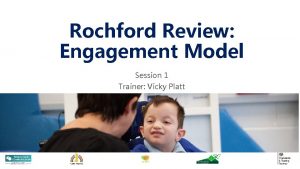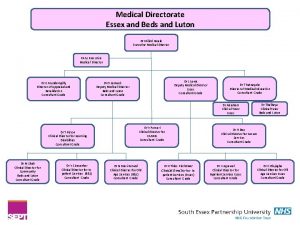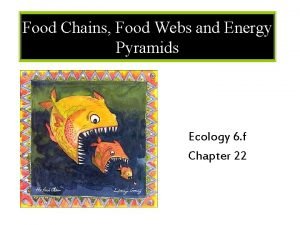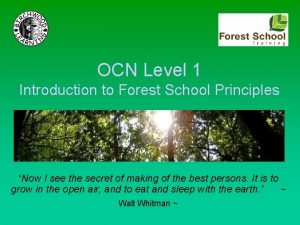Forest School at Rochford Primary What is Forest









- Slides: 9

Forest School at Rochford Primary

What is Forest School?

What are the benefits of Forest School? Development of physical literacy such as co-ordination and balance – children will have the opportunity to explore a large area with a variety of equipment. Increased physical activity – forest school sessions last for 90 minutes. Increased motor development – children will have a chance to develop areas that need strengthening. Better understanding of risk – children will experience ‘higher risk’ activities where they will need to assess and judge and manage risk. Improved emotional well being and mental health – being among nature and trees has been shown to have a positive effect. Counteracts ‘toxic childhood’ – opportunity to immerse themselves in an outdoor space independently. Individualised learning – forest school is flexible, free flow and tailors it support to the child’s interests and stages of development. Gain knowledge – real life learning is at the centre of many of the activities such as tool skills, rope skills and creative skills. Social learning – children can work in collaboration. Discovery and exploration – children will be able to discover information themselves through investigation.

What activities will they be doing? Tool use - whittling, sawing, peeling and cutting. Natural Art - willow work, leaf art, wood art and mud art. Knots - reef, round turn 2 half hitches, open clove hitch, lumber hitch and larks head. Rope skills - rope swing, rope walks, lashings, frappings and wrappings. Den building - natural and man-made materials. Sensory skills- scavenger hunts, seasonal work, mud work and leaf identification. Reflection – time to be quiet, relax and experience mindfulness skills. Fire skills – using and enjoying a camp fire with assistance.

Why are we doing Forest School? Essex is the second lowest coverage of trees in the UK. Awareness of the environment is paramount for survival of our native species. National Trust research shows children are playing for an average of 4 hours a week outside, compared to their parents who spent on average 8 hours.

When and Who? Year 2 will be the only class participating in the Forest School programme in this school year. The children will be lead by Miss Austin (Level 3 forest school accredited practioner and Year 2 teacher), Miss Styles (Pastoral lead) and Mrs Austin (helper). Forest school will take place every Friday afternoon for 90 minutes. Each session will include 15 pupils from year 2, so the groups will be rotated weekly. While 1 group is at the forest school session the other will be completing normal lessons inside with Mrs Hayes (Teaching Assistant). This is due to a 1: 5 ratio guideline. The sessions will take place on the school grounds where an area is being developed with willow saplings, a log circle, natural materials such as dead logs and branches and trees for planting are being delivered in march. The sessions will begin on February 1 st 2019. The first Friday of February.

What do the children need to bring? 1. 2. 3. 4. 5. 6. 7. 8. On the timetable provided it will show you the date your child will be taking part in a forest school session. On that day your child should come to school in normal school uniform, but please make sure that your child also has ‘old’ clothes to change into for the session. These clothes should include: Long sleeved T-shirt. Long trousers. A sweatshirt, jumper or fleece. Sturdy shoes such as welly boots, trainers or walking boots. Waterproof jacket. In the summer, a sun hat and sun cream. In winter, a woolly hat, extra layers and gloves. Bottle of water

Health and Safety The health and safety to all participants is central to everything undertaken within the Forest school programme. Each session is risk assessed. Each activity is risk assessed. Activities will be added gradually so children have sufficient knowledge and understanding. Knife skills and fire skills have 1: 1 ratio guidelines in place. Miss Austin is First Aid trained to the highest level. Health and safety procedures will follow normal school protocol. Weather checks. Ratio of 1: 5 enables children to be supervised by an informed adult helper.

Questions
















